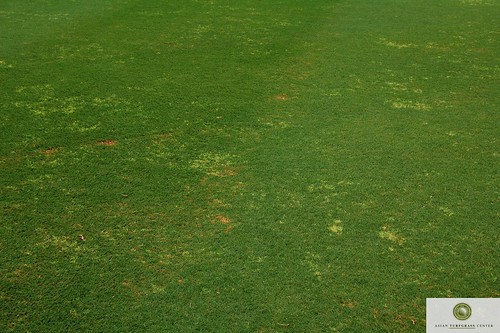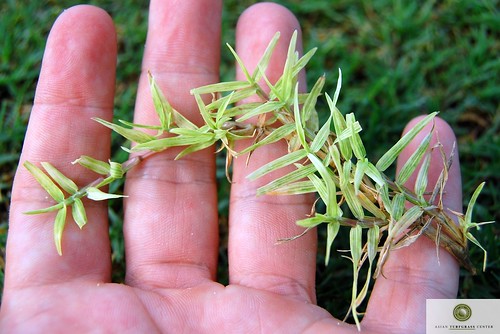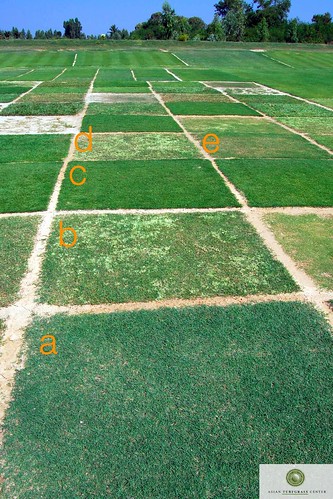
I call this a disease only because the Compendium of Turfgrass Diseases lists it as a mollicute disease. But it is not a fungus, and cannot be controlled with any pesticide. The only way to get rid of it is to physically remove the infected plants. That is the bad news.

Once you have this bermudagrass white leaf on your golf course, you can expect to have entire plants that lose chlorophyll and turn yellow or white and then eventually die. In studies conducted at the Asian Turfgrass Center in 2007 and 2008, we determined that infected plants usually die from four to twelve weeks after symptoms appear. The symptoms are caused by a phytoplasma and that phytoplasma is transferred from plant to plant by insect vectors such as leafhoppers.
Now for the good news. First, the infected plants do die and are overtaken by healthy, chlorophyllous plants. Second, the bermudagrass white leaf infections tend to be most extensive on newly-established golf courses, and after two years of growth the problem seems to diminish. That makes sense, because plants without chlorophyll are not going to be successful in competing with healthy plants, so one of the recommended treatments for bermudagrass white leaf is simply to manage for healthy bermudagrass and you will choke out the infected plants. Thirdly, and what I found most surprising, is that there seems to be big differences in the susceptibility of different varieties of bermudagrass to bermudagrass white leaf.
We grew varieties such as Tifsport, common, Savannah, Riviera, Tifway, Tifgreen (or similar, collected from a golf course supposed to be planted to Tifgreen), Mountain Green, and Tifdwarf, among others, all grown under the same conditions in adjacent plots. What we noticed, and measured, was that certain varieties seem especially susceptible to bermudagrass white leaf infection. At a time when Tifway and Tifsport and Mountain Green had less than 10% infection, varieties such as common, Savannah, and Riviera had more than 60% infection.

In the photo above (click to view a larger version), plots maintained as fairway at Asian Turfgrass Center's research facility near Bangkok show different susceptibility to bermudagrass white leaf.
a - Tifway, no infection
b & d - Riviera, severe infection
c - seashore paspalum, immune
e - Tifsport, minimal infection
My advice about managing bermudagrass white leaf is to choose a variety that has less tendency to become infected (such as Mountain Green, Tifsport, or Tifway), perform cultural practices to encourage healthy bermudagrass and the white leaf will eventually go away, and do not buy stolons or sod from a nursery where this pathogen is present.


























 Well, like the others (Megan, call sign 'Wraith'-
Well, like the others (Megan, call sign 'Wraith'- 










 Happy belated New Year to everyone! I wanted to thank John for the wonderful birthday post! What a great photo and yes it has been cold enough here to warrant hair on every millimeter of skin! Although the winter in the Midwest has not been as abnormally cold when compared to other parts of the country, we have had some extended periods of extreme cold and snow cover since December 9th. South of I-80 there is not as much snow on ground as areas north of I-80. So there is not a lot to talk about in the Upper Midwest, except that ice damage could likely be an issue this year. Why? We haven't completely lost snow cover, but we have had some melting that has probably lead to ice formation underneath the snow. So you may want to keep an eye on areas that are prone to ice damage.
Happy belated New Year to everyone! I wanted to thank John for the wonderful birthday post! What a great photo and yes it has been cold enough here to warrant hair on every millimeter of skin! Although the winter in the Midwest has not been as abnormally cold when compared to other parts of the country, we have had some extended periods of extreme cold and snow cover since December 9th. South of I-80 there is not as much snow on ground as areas north of I-80. So there is not a lot to talk about in the Upper Midwest, except that ice damage could likely be an issue this year. Why? We haven't completely lost snow cover, but we have had some melting that has probably lead to ice formation underneath the snow. So you may want to keep an eye on areas that are prone to ice damage.
